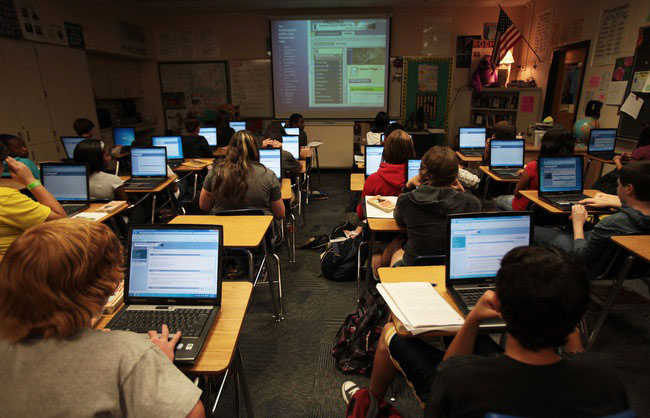How Does Technology Motivate Students To Learn
In today's rapidly evolving digital landscape, technology has become an integral part of our daily lives, and its impact on education is undeniable. As educators and parents seek innovative ways to engage students and enhance learning outcomes, technology emerges as a powerful tool to motivate and inspire learners of all ages. This article explores the various ways in which technology motivates students to learn, examining its benefits, challenges, and best practices for implementation.

Interactive and Engaging Learning Experiences
One of the primary ways technology motivates students is by creating interactive and engaging learning experiences. Traditional teaching methods often rely on passive listening and rote memorization, which can be tedious and uninspiring for many students. In contrast, technology offers a wide array of interactive tools and platforms that make learning more dynamic and enjoyable.
For example, educational apps and games transform abstract concepts into tangible, visual experiences. Students can explore virtual worlds, conduct simulated experiments, and solve puzzles, all while learning important academic concepts. This gamification of learning taps into students' natural curiosity and desire for challenge, making the educational process more engaging and memorable.
Moreover, interactive whiteboards and touchscreen devices allow for hands-on learning experiences in the classroom. Students can manipulate digital objects, draw diagrams, and participate in collaborative activities, fostering a more active and participatory learning environment.
Personalized Learning Paths
Technology enables the creation of personalized learning paths, tailoring education to each student's unique needs, interests, and pace. Adaptive learning platforms use artificial intelligence to assess a student's performance and adjust the difficulty and content of lessons accordingly. This personalization ensures that students are consistently challenged without becoming overwhelmed or bored.
By allowing students to progress at their own pace, technology helps build confidence and motivation. Struggling learners can take the time they need to master concepts without feeling left behind, while advanced students can move ahead to more challenging material. This individualized approach fosters a sense of ownership over one's learning journey, encouraging students to take initiative and stay motivated.
Immediate Feedback and Progress Tracking
One of the most powerful motivators in learning is the ability to see progress and receive timely feedback. Technology provides instant feedback on quizzes, assignments, and assessments, allowing students to quickly identify areas for improvement and celebrate their successes.
Digital learning platforms often include progress tracking features, enabling students to visualize their growth over time. This tangible representation of achievement can be incredibly motivating, encouraging students to set and work towards personal learning goals.
Furthermore, technology facilitates more efficient communication between teachers, students, and parents. Online gradebooks and learning management systems provide real-time updates on academic performance, fostering a collaborative approach to education and ensuring that students receive timely support when needed.
Access to a World of Information
The internet has democratized access to information, providing students with an unprecedented wealth of knowledge at their fingertips. This vast repository of resources motivates students by satisfying their curiosity and enabling self-directed learning.
When students encounter a topic that piques their interest, they can easily delve deeper through online research, videos, and interactive content. This ability to explore subjects beyond the confines of textbooks and curricula fosters a love for learning and encourages students to take ownership of their education.
Moreover, technology connects students with experts and peers from around the world. Virtual field trips, video conferences with professionals, and online collaboration with international classmates expand students' horizons and provide real-world context to their studies.
Development of Digital Literacy and 21st Century Skills
As technology becomes increasingly prevalent in the workplace and society, students are motivated to learn digital skills that will be crucial for their future success. By integrating technology into education, schools prepare students for the demands of the modern world, making learning feel relevant and purposeful.
Students develop critical digital literacy skills, such as information evaluation, online communication, and digital content creation. These competencies not only enhance their academic performance but also prepare them for future careers and lifelong learning.
Furthermore, technology-enhanced learning often involves collaboration, problem-solving, and critical thinking – essential 21st-century skills that are highly valued by employers. As students see the practical applications of their learning, they become more motivated to engage with their education.
Flexibility and Accessibility
Technology has made learning more flexible and accessible than ever before. Online courses, digital textbooks, and educational videos allow students to learn anytime, anywhere. This flexibility is particularly motivating for students who may struggle with traditional classroom settings or have commitments outside of school.
For students with disabilities, assistive technologies remove barriers to learning, providing equal opportunities and boosting motivation. Text-to-speech software, closed captions, and adaptive devices ensure that all students can access educational content and participate fully in their learning journey.
Creative Expression and Project-Based Learning
Technology provides powerful tools for creative expression and project-based learning, allowing students to demonstrate their knowledge in innovative ways. Instead of traditional essays or presentations, students can create multimedia projects, design websites, or produce short films.
This opportunity for creative expression is highly motivating, as it allows students to showcase their unique talents and perspectives. Project-based learning also encourages deeper engagement with the material, as students apply their knowledge to real-world problems and scenarios.
Gamification and Rewards Systems
Many educational technologies incorporate gamification elements and rewards systems to motivate students. Points, badges, and leaderboards tap into students' competitive spirit and desire for recognition, encouraging them to engage more deeply with their learning.
These game-like elements can make even challenging subjects more appealing and help students develop a growth mindset. As they see their "scores" improve and earn virtual rewards, students are motivated to persist through difficulties and strive for mastery.
Enhanced Collaboration and Peer Learning
Technology facilitates collaboration among students, both within the classroom and across geographical boundaries. Online discussion forums, shared documents, and virtual group projects allow students to work together, share ideas, and learn from one another.
This collaborative approach is motivating for several reasons. It taps into students' social nature, makes learning more enjoyable, and exposes them to diverse perspectives. Peer learning can also boost confidence, as students take on the roles of both learner and teacher.
Preparation for a Tech-Driven Future
Finally, the integration of technology in education motivates students by preparing them for a future where digital skills are essential. As students become proficient in using various technologies, they gain confidence in their ability to adapt to new tools and platforms.
This preparation for the future of work and lifelong learning is a powerful motivator. Students recognize that the skills they're developing through technology-enhanced learning will be valuable throughout their lives, giving purpose and relevance to their educational experiences.
Challenges and Considerations
While technology offers numerous benefits for student motivation, it's important to address potential challenges:
Digital divide: Ensure equitable access to technology and internet connectivity for all students.
Screen time concerns: Balance technology use with offline activities to promote overall well-being.
Distractions: Teach students to manage digital distractions and use technology responsibly.
Teacher training: Provide ongoing professional development to help educators effectively integrate technology.
Privacy and security: Implement robust measures to protect student data and teach digital citizenship.
Conclusion
Technology has revolutionized the way students learn, offering powerful tools to motivate, engage, and inspire. From interactive experiences and personalized learning to immediate feedback and global connectivity, technology enhances education in myriad ways. As we continue to navigate the digital age, the thoughtful integration of technology in education will be crucial in preparing students for success in an ever-changing world.
By harnessing the motivational power of technology, educators can create dynamic, student-centered learning environments that foster curiosity, creativity, and a lifelong love of learning. As we look to the future, the continued evolution of educational technology promises even more innovative ways to motivate and empower students on their educational journeys.




